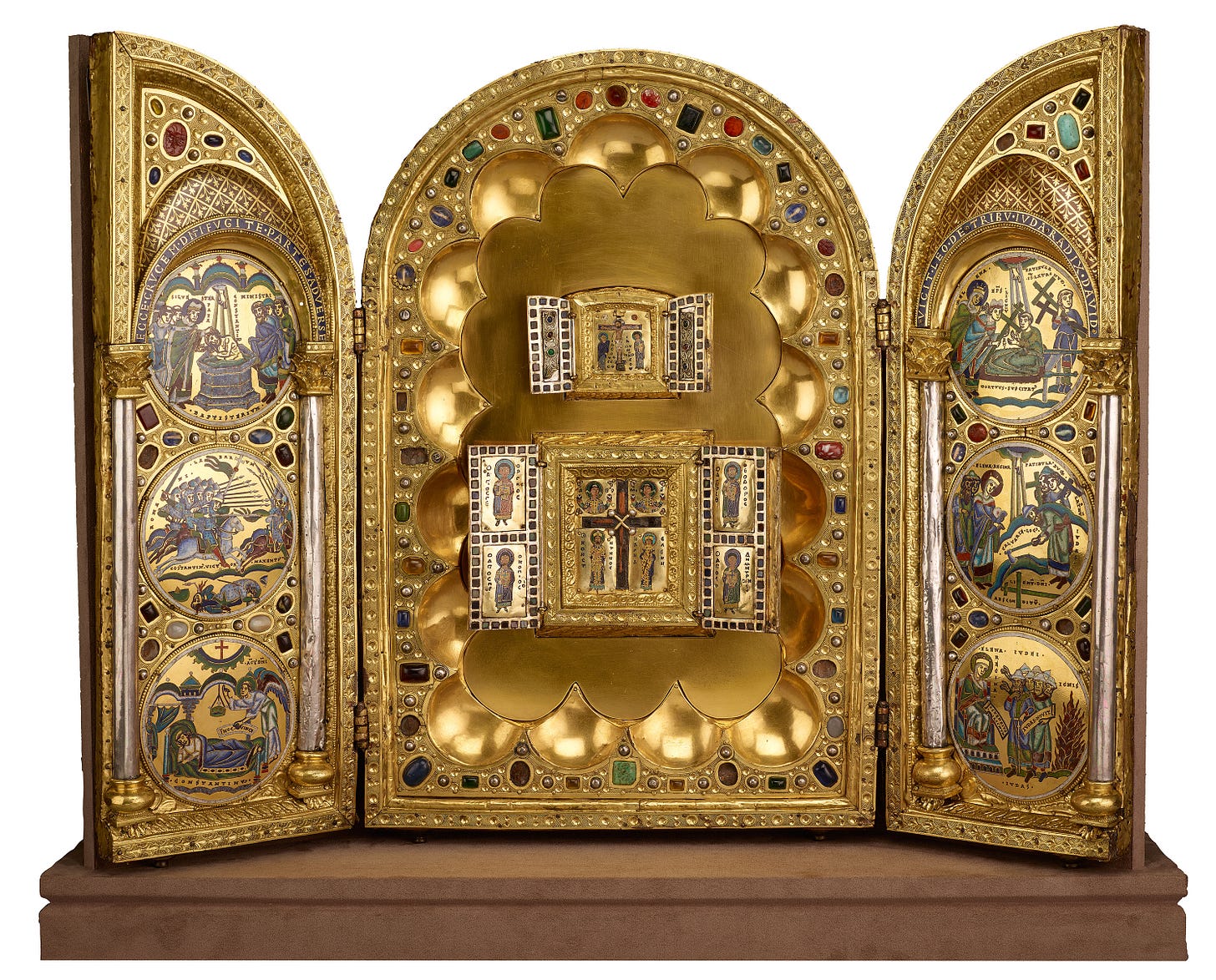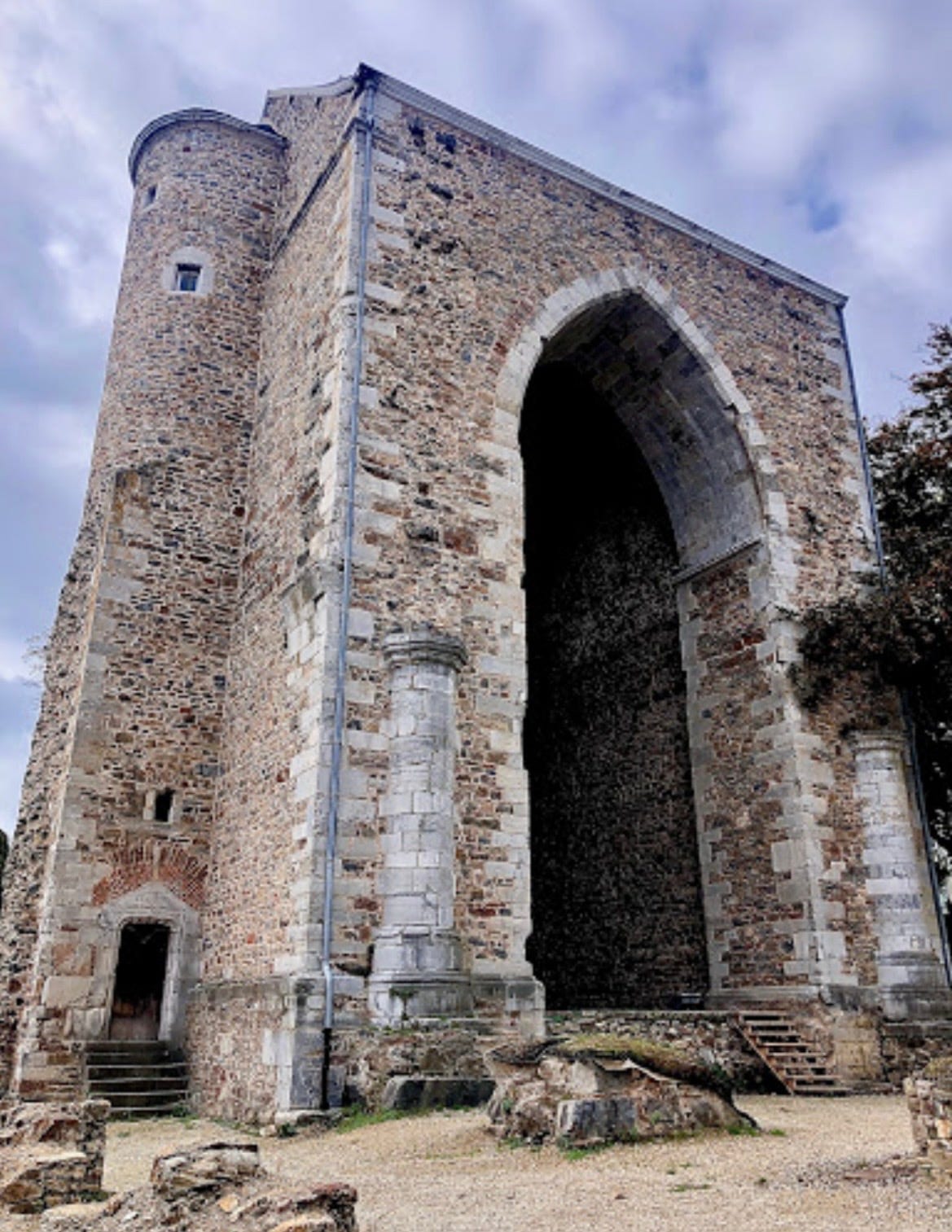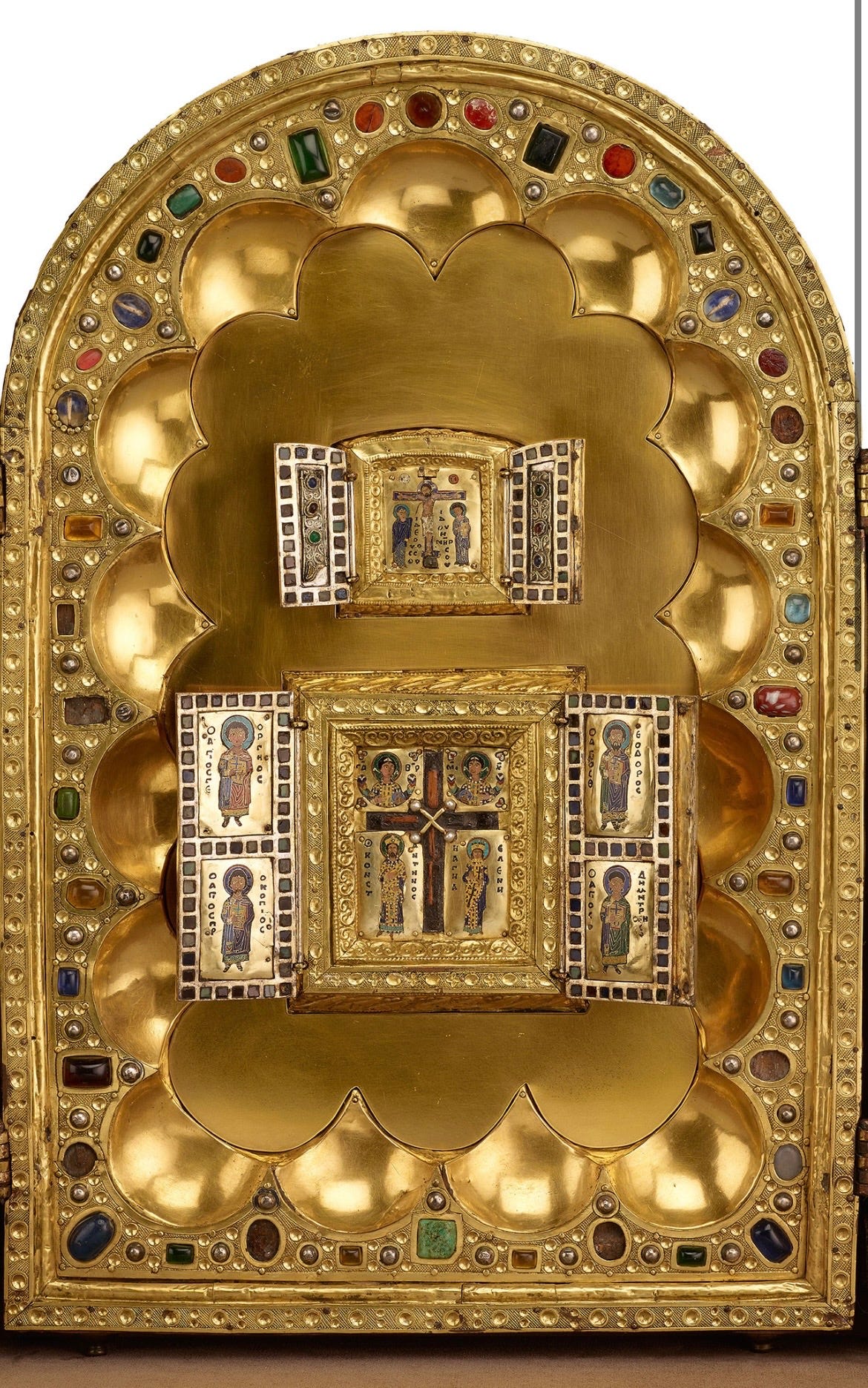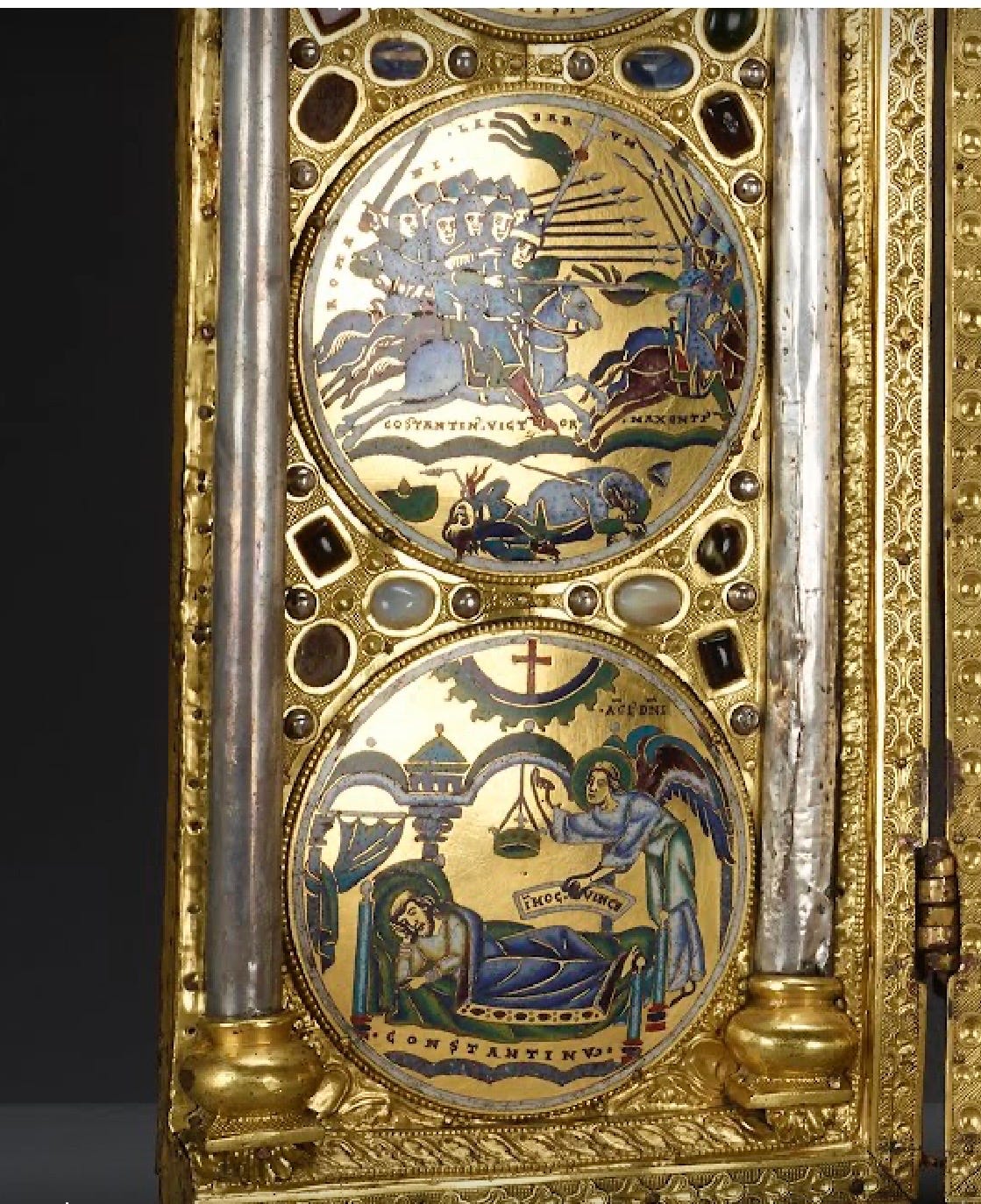“By his Cross we are saved. The instrument of torture which, on Good Friday, manifested God's judgement on the world, has become a source of life, pardon, mercy, a sign of reconciliation and peace.”—Pope Benedict XVI, Feast of the Exaltation of the Cross, 2008

Saved from the murderous caprices of the French Revolutionaries, the tryptich is one of few survivors of Stavelot Abbey. All that remains of the Abbey Church itself is the 11th century Romanesque1 arch. The Benedictine Abbey was once a center of the 12th-century Renaissance, and flourished until the French revolutionaries uprooted and destroyed the Church as well as all the grounds in 1794. Fortunately, the last abbot, Celestine Thys, escaped with this magnificent tryptic which holds a piece of the True Cross, acquired by Abbot Wibald (1130-1158) on one of his diplomatic trips to Constantinople.
It’s now on display at the Morgan Library, restored. In its original home, monks only opened it for veneration on special feasts. Imagine the reliquary open on the altar in a Romanesque cathedral, illuminated by the dance of candlelight for especially holy days of the Christian calendar.
One occasion for unveiling the relic would be today’s feast, the Exaltation of the Cross. This feast celebrates Saint Helena’s discovery of the True Cross2 on September 14th, 320 A.D., and Emperor Heraclitus’s recovery of it from the Persians in 638. On this day, pilgrims gathered at the Saint Remacle Pilgrimage church in Stavelot, Belgium to venerate the cross and celebrate the feast.
Medievals understood the importance of physicality and place, which inspired them to go to great lengths to make pilgrimage to the Holy Land. However, for most Christians, such a treacherous and expensive journey would be impossible. One way for the faithful to enact this pilgrimage was to venerate relics of the True Cross, the instrument upon which Christ achieved our salvation.
After Saint Helena found Jesus’s Cross underneath a temple dedicated to Venus just outside the city walls, she divided it into three fragments, keeping one piece in Jerusalem and sending the other two to Rome and Constantinople. Fragments of the cross credibly connected to these three original fragments were especially valued.3
In the medieval imagination, heavenly Jerusalem loomed large. The gilded liturgical art of the period, often covered with jewels, is meant to reflect God’s majesty and stir our own longing for the heavenly city. Art of this period is imbued with scriptural references and complex symbolism. John’s description in Revelation seems particularly relevant to the Stavelot tryptich:
The wall is built of jasper, while the city is pure gold, clear as glass. The foundations of the wall of the city are adorned with every jewel; the first was jasper, the second sapphire, the third agate, the fourth emerald, the fifth onyx, the sixth carnelian, the seventh chrysolite, the eighth beryl, the ninth topaz, the tenth chrysoprase, the eleventh jacinth, the twelfth amethyst. And the twelve gates are twelve pearls, each of the gates is a single pearl, and the street of the city is pure gold, transparent as glass. (Revelation 21:19-21)
The bejeweled triptych, which features fragments of the True Cross is made to be a microcosm of the heavenly Jerusalem, as is the church building. It also echos the Ark of the Covenant in the Old Testament.
This dazzling Romanesque triptych opens to two smaller inlaid Byzantine triptychs, inviting a pilgrim to move from meditating on the narrative on the outside to the most important triptych in the center, which contains a piece of the True Cross adorned with four pearls.
Taken together, the inscriptions atop the wings, drawn from the Psalms and Revelation, make up the antiphon for today’s feast: “Behold the cross of the Lord; let all his enemies flee in terror; the lion of Judah, David's seed, is victorious, alleluia.”
The three-part structure of the triptych points to the structure of the Church where space becomes more holy leading up to the sanctuary where the altar is.4 In the triptych, the images get progressively more sacred as we move from Constantine and Helena, to the crucifixion icon, and finally to the True Cross relic. This likeness is accentuated by the way the arch of the triptych resembles the Romanesque arch of the church building, and the enamel roundels resemble the stories of stained glass windows. Both are meant to be read from the bottom up.
In delightful Romanesque fashion, the enameled roundels tell the story of the finding of the True Cross. Constantine’s story lays the foundation for Helena’s pilgrimage.
We start on the bottom left with an Angel waking Constantine from a dream with the words “in hoc vincis:” in this conquer. In Eusebius’s account, Constantine receives the dream in tent before the battle. Here, he’s shown in a palace, which probably points to his future role as emperor, as does the hanging crown.
Notably, the artist never depicts Constantine wearing the crown. With this crownless presentation of Constantine, the Western artist gently corrects the depiction of him in the central Byzantine icon, where he’s depicted with a halo. The Eastern church sees Constantine as “equal to the apostles” for the way he spread the Gospels, while the Western Church sees Constantine’s sanctity in a much more ambiguous light.
The next medallion depicts Constantine charging at Maxentius in the battle of the Milvian bridge. The inscription reads “labarum,” which refers to the weapon with which Constantine hoists the cross in the air for all to see. Finally, the third roundel depicts Pope Sylvester baptizing Constantine in an octagonal font, which symbolizes the eschatological “eighth day” of the new creation. It’s notable that only here does God’s hand reach down to bless Constantine.
On the right side, the artist labels Helena, Constantine’s mother, “Regina:” Queen. She’s presented rather majestically, with a crown and halo sitting atop a throne. The basilica-like throne recalls the numerous basilicas she commissioned under her son’s rule. This presentation reflects the heavenly reality of Helena’s sainthood.

Here, Helena interrogates the Jewish elders about the location of the Cross— “ostendite lignum:” Show me the wood. In the next roundel Helena supervises the excavation under the temple of Venus. She points to the third cross, which is labeled as “lignum domini absconditum:” the hidden wood [the Cross]. The crosses of the two thieves are labeled in the back.
Above the scene, the hand of God blesses Helena’s endeavor, confirming she has found the fragments of the Cross. The True Cross is also revealed here by the titular plate and the light green color, a color medieval artists commonly used to show that the Cross is also the tree of life. As Saint Ephraim says: “O the power of the Cross! The Tree of the Cross has become an olive tree and a vineyard, and likewise an ear of wheat and a land of harvest.” Church Fathers understood Christ and the Eucharist to be the fruit of that tree.
In the last medallion, Helena, now labeled “Sancta:” Saint, takes the crosses to be tested. She has the cross of Christ placed on a dead boy, after which the boy is miraculously brought back to life. In this medallion, Helena’s crown is two-tiered to reflect the importance of her discovery. Both this medallion and the baptism of Constantine are types of Resurrection. Romanesque artists commonly paired scenes like this to reveal meaning.
After moving through this story, one is drawn into the following triptych in which a scene of the Annunciation on the doors opens to the scene of the Crucifixion. The artist identifies Mary as “the gate to our salvation.” Inside the icon, Jesus’s crucifixion is revealed. The blood and water spurt out of Christ’s side, witnessed by Mary and John, reminding us of the suffering he endured for our salvation.
Above the horizontal arms, are the sun and moon, cosmic symbols which remind us that the cross unites heaven and earth. As Gregory of Nyssa explains, “By the Cross, Christ reconciles the whole fourfold universe…The Cross is the axis mundi, the center of the world, which by its four sides unites heaven and hell and the whole world in space and time. Christ reigns from the center of the world as its Crucified King.”
Finally, after contemplating Christ’s passion and death, we are invited to meditate upon the relic of the true cross pictured below the crucifixion. The four evangelists cover the outside doors that open to the true cross, symbolizing the fact that the Gospels reveal the saving power of the Cross.
Four Byzantine military saints—George, Procopius, Theodore, and Demetrius—are protectors of the cross. In the central panel, Constantine and Helena stand witness to the relic of the Triumphant Cross along with two angels.
Lastly, we move from meditating on the suffering of the passion to the glory of the Cross. The four pearls adorning the relic call us to meditate on the glory of the cross. They also recall the words of the apostle Andrew, which are included in the responsory of the divine office: "Hail Cross, which art dedicated in the body of Christ and adorned with his members even as with pearls.”
For centuries, monks at Stavelot Abbey sang this 6th-century hymn while they venerated the relic of the True Cross in this magnificent triptych. The hymn by Fortunatus, known as the Pange Lingua or Crux Fidelis, is still part of the Divine Office for today’s ancient feast.5
Faithful Cross! above all other, one and only noble tree! None in foliage, none in blossom, None in fruit thy peer may be: Sweetest wood, and sweetest iron! Sweetest weight is hung on thee. Bend thy boughs, O tree of glory!
Helena’s discovery has been documented by numerous fourth and fifth century historians, including Eusebius of Caesarea, Rufus of Aquileia, Theodoret of Cyprus, Sozomen of Gaza, Socrates Scholasticus, Gelasius of Cyzicus, and Alexander of Cyprus. Each account documents that the cross was found under the temple of Venus and that Helena generously gave alms during her trip and freed prisoners and slaves.
“This wasn't a case of fetishism or belief in magic, however. In this account, there are three elements worth noting: first, God's power, which acts as the healing force; second, the woman's faith in seeking help; and third, the mediation of a concrete object. It is on this evidence that Christians developed a belief in the power of relics as objects that, through physical contact, mediate between this mortal world and the Kingdom of Heaven.” (Grzegorz Gorny and Janusz Rosikoń, Witness to Mystery p. 6)
The doors of the temple in Jerusalem open to the sacred space which led to the Holy of Holies and the Ark of the Covenant, “God’s footstool on earth.” Likewise, the Church opens to a holy space that leads to the sanctuary where the altar is.
The first five verses of the Pange Lingua are sung at Matins and the last six are sung at Lauds. Sometimes this latter part is called the “Crux Fideles.” https://www.cathcorn.org/hotbam/52.html















Thank you Amelia! I remembered this masterpiece from medieval art history courses almost fifty years ago, but haven’t thought of it since. Your explanation of the iconography is superb (I have a PhD in Renaissance art history, and rarely see young scholars today capable of so deep and cogent an explanation as this).
I sent screenshots and commentary to my nine year old granddaughter in Belgium - her name is (h)Elena.
Beautiful. Thank you so much for this detailed description in words, images & chant. What a gift you’ve given us on this day that we honor the Exaltation of the Cross. 🙏🏻💛🙏🏻